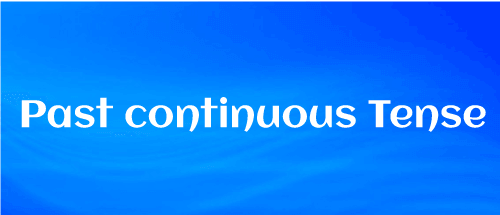Past Continuous Tense
Past Continuous Tense is also called Progressive Tense. It expresses the action that was started in the past and was also continuing in the past. That action is not related to the present time. The structure of past continuous tense is:

Subject + Was/Were + V4 ('ing' form of verb) + Other Words
Examples:
- The children were playing in the park.
- Mehak was sleeping when her friends came.
- I was cycling on the road.
- My mother was writing a letter to the municipal corporation when she heard about the incident.
- They were studying in their room.
Structure of past continuous tense in all forms of sentences
1. Affirmative Sentences: In affirmative sentences of past continuous tense, 'was' and 'were' are used with the 'ing' form of the verb. 'Was' is used with the subject's first and third-person singular number, while 'Were' is used with the subject's first and third-person plural number and second-person singular/plural number. The structure of the sentence is:
Subject + Was/Were + V4 ('ing' form of verb) + Other Words
Examples:
- I was baking the cake.
- We were baking the cake.
- You were baking the cake.
- They were baking the cake.
- John was baking the cake.
- Girls were baking the cake.
2. Negative Sentences: In negative sentences of past continuous tense, 'not' is used after 'was' & 'were'. The structure of the sentences is:
Subject + was/were + not + V4 ('ing' form of verb) +other words
Examples:
- I was not baking the cake.
- We were not baking the cake.
- You were not baking the cake.
- They were not baking the cake.
- John was not baking the cake.
- Girls were not baking the cake.
3. Interrogative Sentences: In interrogative sentences of past continuous tense, 'was' and 'were' are used before the subject. The structure of the sentence is
Was/were + subject + V4 ('ing' form of verb) + other words
Examples:
- Was I baking the cake?
- Were we baking the cake?
- Were you baking the cake?
- Were they baking the cake?
- Was john baking the cake?
- Were girls baking the cake?
4. Negative Interrogative Sentences: In negative interrogative sentences of past continuous tense, 'was' & 'were' is used before the subject, and 'not' is used after the subject. The structure of the sentence is :
Was/were + subject + not + V4 ('ing' form of verb) + other words
Examples:
- Was I not baking the cake?
- Were we not baking the cake?
- Were you not baking the cake?
- Were they not baking the cake?
- Was john not baking the cake?
- Were girls not baking the cake?
Uses of past continuous tense
-
It is used to denote the action that was in progress in the past.
Examples:
Children were doing their homework at night.
When he reached home, it was still raining.
-
It is used to denote more than one action in progress at a time in the past.
Examples:
My younger brother was watching a movie while my elder sister was doing her study.
I was doing my homework when my mother was cooking food.
-
It is used to show the persistent habit in the past. To show that habit, the words always, continually, constantly, and forever are used.
Examples:
She was always quarreling.
He was constantly giving his good performance in class.
-
It is used in indirect speech for changing the direct speech of the present continuous tense.
Examples:
Direct: He said, "I am going to market".
Indirect: He said that he was going to market."
Some important facts about past continuous tense
- Past continuous tense expresses the action that was in progress in past time but was not completed by that time.
- In the past continuous tense, words like always, constantly, continually, etc., are used to tell the often-repeated action in past time.
- It indicates the incomplete action in the past and does not tell about the starting and ending time of the action.
-
It tells about two actions in progress in the past at the same time.
Example: While I was doing my homework, my brother was watching a movie.
-
It is also used to express one completed action (simple past tense) and another ongoing action in the past. The duration of the completed action is short, while the ongoing action is longer.
Example: While I was playing football, my mother telephoned.
I was playing football when my mother telephoned.
Note: In the above sentences, 'playing football' is 'long action', so it is expressed in past continuous tense while 'telephoned' is 'short action', which is expressed in past indefinite tense. 'When' is used for the short action, and 'while' is used for the long action.
|

 For Videos Join Our Youtube Channel: Join Now
For Videos Join Our Youtube Channel: Join Now









